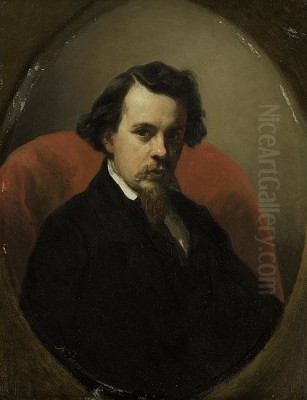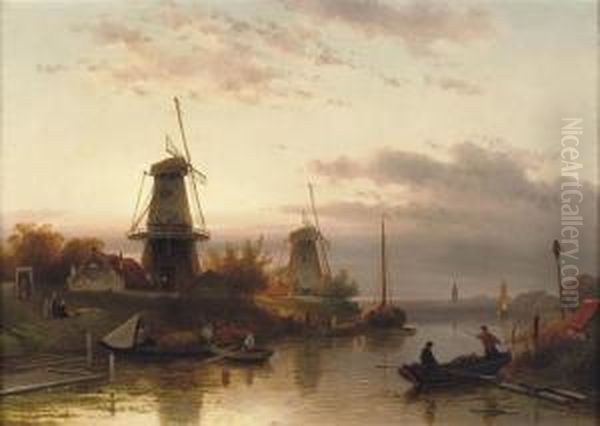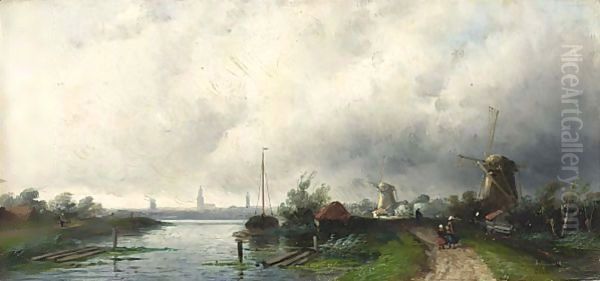
Charles Henri Joseph Leickert stands as a significant figure in 19th-century European art, a painter whose canvases vividly evoke the atmosphere and charm of the Netherlands. Though born in Brussels, Belgium, Leickert is inextricably linked with Dutch painting, having spent the vast majority of his long and productive career capturing its unique landscapes, particularly its luminous winter scenes. He was a master of Dutch Romanticism, skillfully blending detailed observation with an idealized, atmospheric sensibility that continues to resonate with viewers today.
Leickert's journey into the art world began in Brussels, where he was born on September 22, 1816. From an early age, he displayed a clear aptitude for drawing and painting. Recognizing his son's burgeoning talent, Leickert's father encouraged his artistic pursuits, setting him on a path that would define his life. This early support was crucial, allowing him to develop his foundational skills and fostering a passion that would lead him to the heart of the Dutch art scene.
Formative Years and Artistic Training
Seeking formal training and immersion in a vibrant artistic environment, the young Leickert moved to The Hague in the Netherlands around 1841. This move proved pivotal. The Hague was a center for landscape painting, and Leickert sought out instruction from established masters. He studied under several prominent Dutch artists who shaped his technical abilities and artistic vision.
Among his teachers were Bartolomeus Johannes van Hove (1790-1880), a respected painter known for his cityscapes and church interiors, and Wijnand Josephus Nuijen (1813-1839), a highly talented but tragically short-lived painter whose romantic landscapes were already gaining acclaim. Van Hove provided Leickert with a solid grounding in perspective and architectural rendering, skills evident in Leickert's later townscapes. Nuijen, though his influence was brief due to his early death, likely exposed Leickert to the burgeoning Romantic sensibility in Dutch art.

However, the most significant influence on Leickert's development was undoubtedly Andreas Schelfhout (1787-1870). Schelfhout was a leading figure in Dutch Romantic landscape painting, particularly renowned for his winter scenes. Studying with Schelfhout profoundly impacted Leickert, steering him towards the specialization that would become his hallmark: the Dutch winter landscape. Schelfhout's meticulous technique, combined with his ability to capture the crisp light and specific atmosphere of winter, provided a powerful model for his pupil. Leickert absorbed Schelfhout's lessons on composition, detail, and the rendering of ice and snow, while gradually developing his own distinct style. He remained in The Hague, learning and painting, until about 1846.
The Amsterdam Period: Maturity and Recognition
Around 1849, Leickert relocated to Amsterdam, the bustling commercial and cultural heart of the Netherlands. This marked the beginning of his most productive and successful period, which lasted until 1883. In Amsterdam, Leickert fully established himself as a professional artist, honing his craft and building his reputation. The city, with its intricate network of canals, historic architecture, and surrounding countryside, provided endless inspiration.
His dedication and talent did not go unnoticed. In 1856, a significant milestone in his career, Leickert was elected a member of the prestigious Royal Academy of Art in Amsterdam (Koninklijke Academie van Beeldende Kunsten). This membership conferred considerable status and acknowledged his standing within the Dutch art establishment. It placed him among the respected painters of his time and likely facilitated further commissions and exhibition opportunities.
During his decades in Amsterdam, Leickert produced a vast body of work, primarily focusing on the Dutch landscapes that had captivated him. His paintings found favour with the public and collectors, both within the Netherlands and internationally. His works became particularly popular among private collectors in Great Britain and Northern Europe, demonstrating his broad appeal. The consistent demand for his characteristic scenes suggests they struck a chord with the tastes of the burgeoning middle and upper classes of the era.
Leickert's Artistic Style: The Essence of Dutch Romanticism
Leickert painted firmly within the tradition of Dutch Romanticism, a movement that flourished in the Netherlands during the 19th century. This style sought to combine the detailed realism inherited from the Dutch Golden Age masters of the 17th century with a more subjective, atmospheric, and often idealized or nostalgic vision of the landscape. It was a response, in part, to the upheavals of the Napoleonic era and the subsequent desire to celebrate national identity and the beauty of the Dutch homeland.

Artists like Barend Cornelis Koekkoek (1803-1862), often considered the "Prince of Landscape Painting" in Dutch Romanticism, set a high standard for idealized, meticulously rendered scenes. While Leickert shared the Romantic sensibility, his work often possessed a slightly softer, more atmospheric quality compared to Koekkoek's sometimes more dramatic compositions. He focused less on sublime mountain vistas (which Koekkoek sometimes painted after travels) and more on the intimate, flat, water-rich landscapes characteristic of the Netherlands.
Leickert's contemporaries in the Dutch Romantic landscape tradition included painters like Cornelis Springer (1817-1891), renowned for his incredibly detailed and sunlit cityscapes, and Johannes Bosboom (1817-1891), famous for his atmospheric church interiors. While Springer focused on the architectural precision of towns, and Bosboom explored interior light, Leickert carved his niche in the expansive outdoor vistas, particularly those transformed by winter. Salomon Verveer (1813-1876), another Hague School precursor, painted lively beach and town scenes, often with a strong narrative element.
The Allure of Winter
Winter landscapes became Leickert's signature subject. He possessed an extraordinary ability to capture the specific qualities of the Dutch winter: the frozen canals and rivers teeming with life, the snow-dusted windmills standing sentinel against vast skies, the muted light of a short day, and the cozy glow emanating from cottage windows. His winter scenes are rarely bleak or desolate; instead, they often depict bustling activity.
Skaters glide across the ice, figures huddle around fires, horse-drawn sleighs traverse frozen waterways, and people go about their daily chores. This inclusion of lively staffage (small figures animating the scene) adds narrative interest and a sense of community warmth amidst the cold. It connects his work back to 17th-century masters like Hendrick Avercamp (1585-1634), who pioneered the genre of the populated winter landscape. Leickert updated this tradition for the 19th century, infusing it with Romantic atmosphere.
His rendering of ice and snow was particularly masterful. He captured the reflective sheen of frozen water, the soft texture of fallen snow on roofs and branches, and the crisp, sometimes biting, quality of winter air. He understood how winter light interacts with the landscape, creating subtle shadows and highlighting textures. His winter scenes often evoke a sense of nostalgia, a longing for a simpler, perhaps more picturesque, past, which resonated strongly with his audience during a period of increasing industrialization.
Mastery of Light and Atmosphere
A defining characteristic of Leickert's art is his exquisite handling of light and atmosphere. He was particularly adept at depicting the transitional moments of the day – sunrise and sunset – bathing his landscapes in warm, often dramatic, light. His skies are rarely empty; they are filled with dynamic cloud formations, rendered in soft gradations of colour. Pale blues, soft pinks, golden yellows, and subtle greys blend seamlessly to create skies that are both believable and emotionally resonant.
He often employed techniques like backlighting, placing the sun low on the horizon, sometimes partially obscured by a windmill or building. This allowed him to create striking silhouettes and capture the effects of light filtering through haze or reflecting off water and ice. This sensitivity to light effects might show a subtle awareness of broader European trends, perhaps even the early stirrings of Impressionism in France, although Leickert remained fundamentally a Romantic painter focused on detailed rendering rather than capturing fleeting moments with broken brushwork. His goal was to create a harmonious and evocative mood, using light as a key expressive tool.
The overall atmosphere in his paintings is typically one of tranquility and picturesque charm. Even his townscapes, while detailed, often possess a peaceful quality. He selected viewpoints and lighting conditions that emphasized the beauty and harmony of the scene, presenting an idealized vision of Dutch life and landscape. This romanticized view contributed significantly to his popularity.
Composition and Detail
Leickert typically favoured panoramic compositions, offering wide views of the Dutch countryside or expansive stretches of frozen waterways. Windmills are frequent and iconic elements in his work, serving not just as picturesque features but also as vertical anchors in the predominantly flat landscape. He carefully arranged elements like trees, buildings, boats, and figures to create balanced and visually engaging scenes.
While his overall approach was atmospheric, Leickert paid considerable attention to detail. Buildings are rendered with architectural accuracy, the rigging of boats is carefully delineated, and the costumes of the figures are specific to the time and place. This grounding in realistic detail prevents his work from becoming overly sentimental or vague. It provides a tangible sense of place, even as the overall mood is heightened by the Romantic treatment of light and atmosphere.
His level of detail is perhaps less intensely focused than that of his contemporary Cornelis Springer in his townscapes, but it is always sufficient to create a convincing and engaging world. Leickert struck a balance between capturing the broad atmospheric effect and rendering the specific features of the Dutch environment.
Summer Landscapes and City Views
Although best known for his winter scenes, Leickert was also a capable painter of summer landscapes and city views. His summer scenes often depict tranquil rivers winding through lush green fields, dotted with grazing cattle, sailboats, and farmhouses. The light in these works is typically warm and inviting, reflecting the languid pace of a summer day. He applied the same sensitivity to atmosphere in these works, capturing the haze of a warm afternoon or the clear light of a sunny morning.
His city views often focused on the canals and streets of Dutch towns, sometimes in summer, sometimes in winter. Like his landscapes, these scenes are characterized by careful composition, attention to architectural detail, and a focus on atmospheric light. Whether depicting the frozen canals of Amsterdam in winter or a sun-dappled street scene in summer, Leickert consistently aimed to capture the unique character and charm of the Netherlands.
Key Works and Their Significance
While Leickert produced a large number of paintings, often revisiting similar themes due to market demand, several works stand out or are representative of his style:
_Winter Landscape with Skaters near a Town_: This title represents a recurring and highly popular theme for Leickert. Such paintings typically feature a wide expanse of frozen canal or river in the foreground, bustling with skaters and other figures. In the middle ground or background, a town or village with characteristic Dutch architecture and perhaps a prominent church steeple provides context. A windmill is often included. The sky dominates a large portion of the canvas, rendered with his typical atmospheric sensitivity, often depicting the low light of late afternoon or early morning. These works perfectly encapsulate his blend of detailed observation, lively narrative, and Romantic mood.
_Dutch Canal with Windmills at Sunset_ (c. 1852): Works depicting sunsets were another of Leickert's strengths. An example described in the provided text highlights his technique of using indirect lighting. By placing the setting sun behind a windmill, he could create a dramatic silhouette effect while focusing on the golden, pink, and orange hues reflected in the sky and water. This demonstrates his skill in manipulating light for maximum atmospheric impact, creating scenes of serene beauty and tranquility.
_Windmills along a River_: This title, associated with a significant auction result (5,000 mentioned in the source material), points to another classic Leickert theme. Windmills were potent symbols of the Netherlands, and Leickert featured them prominently. Paintings with this theme often show a series of windmills lining a waterway, under either a summer or winter sky, emphasizing the harmonious integration of human industry within the natural landscape. The strong market performance indicates the enduring appeal and recognized value of his work.
_Summer River Landscape with Cattle and Sailboats_: Representing his non-winter output, these scenes showcase his ability to capture the lushness and tranquility of the Dutch countryside in warmer months. Gentle rivers, verdant banks, grazing animals, and leisurely sailboats under expansive, light-filled skies demonstrate his versatility and consistent focus on peaceful, picturesque views of his adopted homeland.
These examples illustrate Leickert's core strengths: his focus on characteristic Dutch scenery, his mastery of light and atmosphere (especially in winter), his ability to create lively yet harmonious compositions, and his consistent appeal to the Romantic sensibilities of his time.
Influences and Artistic Lineage
Leickert's artistic heritage is firmly rooted in Dutch traditions. His most direct mentors were Schelfhout, van Hove, and Nuijen, who connected him to the ongoing Dutch Romantic movement. Through Schelfhout in particular, he inherited a lineage stretching back to the 17th-century Dutch Golden Age masters of landscape.
The influence of painters like Jacob van Ruisdael (c. 1629-1682) and Meindert Hobbema (1638-1709) can be seen in the compositional structures and the love for depicting the specific features of the Dutch land. The specialized winter scenes echo the work of pioneers like Hendrick Avercamp and Aert van der Neer (1603-1677), the latter known for his moonlight and winter landscapes featuring subtle light effects, something Leickert clearly appreciated.
Within his own century, Leickert worked alongside other prominent Romantics like Koekkoek and Springer. While sharing a common cultural context and artistic sensibility, each developed their own specialization. Leickert's focus on atmospheric winter scenes, often with a slightly softer touch than Koekkoek and a broader landscape focus than Springer, defined his unique contribution. He can be seen as a bridge figure, upholding the Romantic tradition just as the next generation, associated with the Hague School – artists like Anton Mauve (1838-1888) and Willem Roelofs (1822-1897) – began to move towards a more realistic, tonal, and plein-air approach inspired by French Barbizon painting. Leickert, however, remained committed to the detailed, atmospheric, and often studio-finished approach of Romanticism.
Later Life in Mainz
After a long and successful career based primarily in Amsterdam, Leickert made another significant move in his later years. In 1887, at the age of 71, he relocated to Mainz, Germany. The reasons for this move are not definitively documented but may have been related to family connections or simply a desire for a change of pace in retirement.
He continued to live in Mainz for the remainder of his life. It is likely he continued to paint, perhaps at a slower pace, drawing on the wealth of sketches and memories accumulated over his decades in the Netherlands. His reputation was already firmly established, and his works were appreciated in Germany as well as in the Netherlands and Britain. Charles Henri Joseph Leickert passed away in Mainz on December 5, 1907, at the venerable age of 91, leaving behind a substantial legacy of work.
Legacy and Conclusion
Charles Henri Leickert occupies a respected place in the history of 19th-century Dutch art. As a leading exponent of Dutch Romantic landscape painting, he captured the specific beauty and atmosphere of the Netherlands with remarkable skill and sensitivity. His specialization in winter scenes, filled with light, activity, and nostalgic charm, proved immensely popular during his lifetime and remains highly sought after by collectors today.
He successfully synthesized the detailed realism inherited from the Dutch Golden Age with the atmospheric and emotional concerns of the Romantic era. His mastery of light, particularly the subtle nuances of winter skies and the warm glow of sunsets, was exceptional. Through countless canvases depicting windmills, frozen canals, skaters, and tranquil summer rivers, he created an enduring and idealized vision of the Dutch landscape.
While perhaps not as revolutionary as the Hague School painters who followed him, Leickert perfected a particular type of landscape painting that resonated deeply with the cultural identity and aesthetic tastes of his time. He stands alongside Andreas Schelfhout, B.C. Koekkoek, and Cornelis Springer as a key figure who defined the character of Dutch Romantic painting. His work continues to offer a window onto a beautifully rendered, atmospherically rich vision of the Netherlands in the 19th century, securing his legacy as a master of the Dutch landscape.